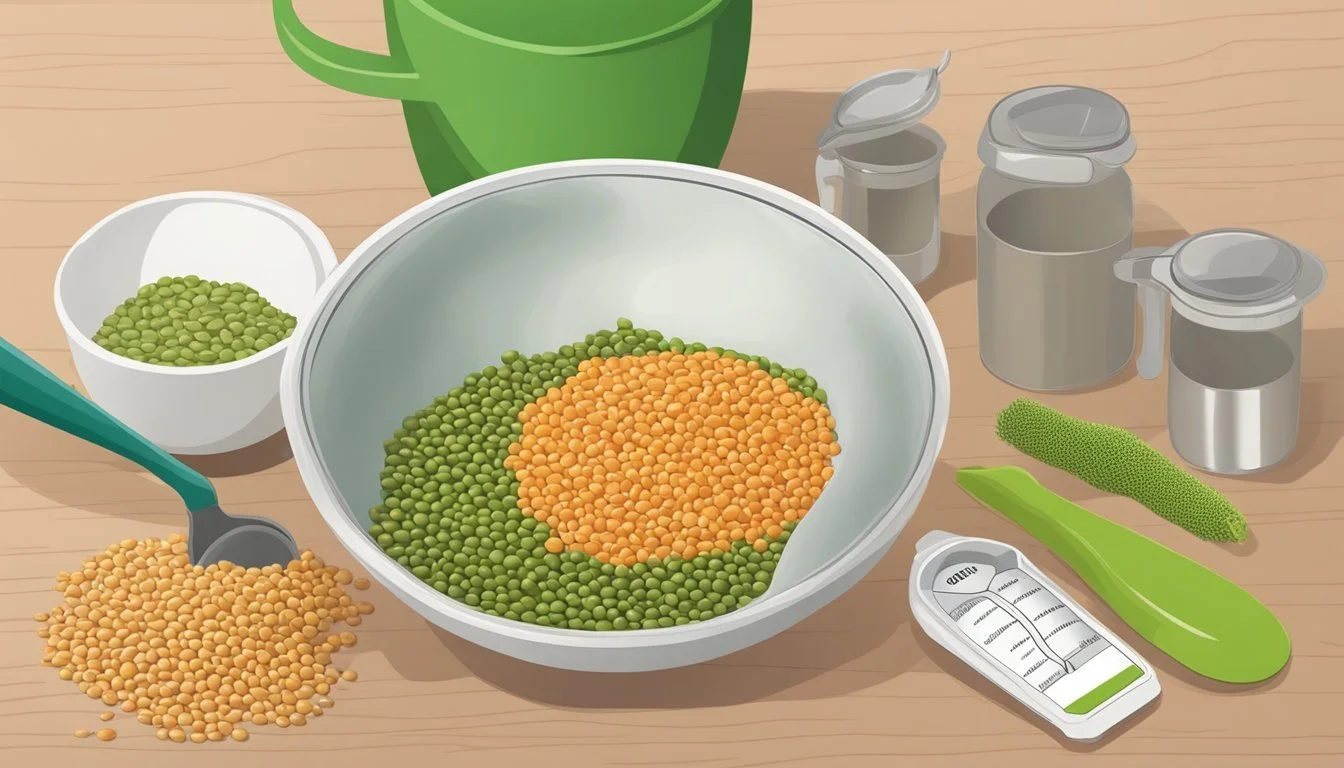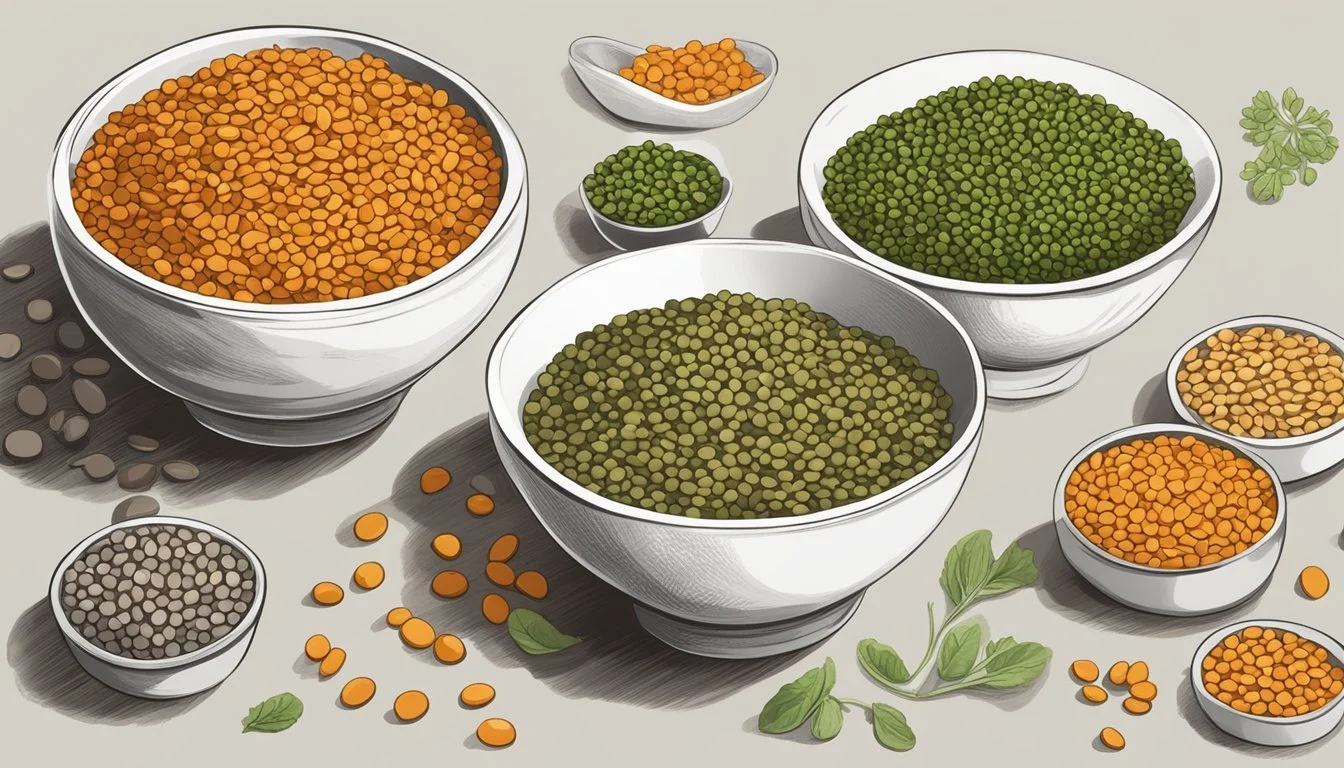How to Substitute Red Lentils for Green Lentils
A Simple Guide
Lentils, a staple in cuisines across the world, bring not just nutrition but also texture and flavor to a variety of dishes. The versatility of lentils is evident in the multiple varieties available, each with its distinct characteristics. Red lentils are a popular choice, known for their quick cooking time and ability to break down into a creamy consistency, making them ideal for thickening soups and dahls. However, when red lentils are not available or a different texture is desired, green lentils serve as a suitable substitute, with a few adjustments to the cooking process.
Green lentils, unlike their red counterparts, hold their shape well and offer a slightly peppery flavor, which can add dimension to a dish. They are commonly used in salads and as a side due to their firm texture even after cooking. The key to successfully substituting green lentils for red is understanding the variations in cooking times and liquid absorption rates. Green lentils require a longer cooking time and may call for adjustments in the amount of liquid used in the recipe to achieve the desired texture.
Understanding Lentils
Lentils are a type of legume known for their nutritional value and versatility in various cuisines. They are a staple in many diets around the world, providing a rich source of protein, fiber, and essential minerals.
Varieties of Lentils
There are several types of lentils, but the most commonly used are red and green lentils.
Red Lentils: These lentils are actually orange in color and are known for their quick cooking time. They tend to become mushy when cooked, which makes them ideal for soups and purees.
Green Lentils: Compared to red lentils, green lentils have a firmer texture and a slightly peppery flavor. They hold their shape well, making them suitable for salads and side dishes.
Nutritional Profile
Lentils are highly nutritious, offering a wealth of vitamins and minerals alongside macronutrients.
Protein: A vital component for muscle repair and growth, lentils are an excellent source of plant-based protein.
Fiber: Essential for digestive health, both red and green lentils are high in dietary fiber.
Minerals: Lentils contain important minerals such as iron, potassium, and magnesium.
Fat: They are low in fat, which makes them a healthy choice for heart health.
Vitamins: Lentils are a good source of B vitamins, particularly folate, which is crucial for cell function and tissue growth.
Culinary Uses
Lentils are extremely versatile in culinary applications due to their variety and nutritional content.
Red Lentils: Their soft texture upon cooking is perfect for thickening dishes like dahls, stews, and curries.
Green Lentils: With their ability to maintain structure, green lentils are often used in dishes that require whole lentils, such as salads, pilafs, and as a meat substitute in vegetarian dishes (What wine goes well with vegetarian dishes?).
The knowledge of these variations allows for appropriate substitution and usage in a myriad of recipes, ensuring both the desired texture and nutritional benefits are achieved.
Differences Between Red and Green Lentils
When substituting red lentils for green lentils, it's crucial to understand their distinctive characteristics in flavor, texture, and cooking time.
Flavor Distinctions
Red Lentils: They possess a subtly sweet taste, making them a versatile ingredient in the kitchen. Even without a strong earthy flavor, red lentils lend a delightful, mild essence to dishes, contributing to a creamy consistency when cooked.
Green Lentils: These lentils are known for their more pronounced earthy flavor, which is robust and somewhat peppery. The taste of green lentils is preferred in recipes where a hearty, distinct lentil presence is desired.
Texture Comparison
Red Lentils: They have a tendency to break down and become soft during cooking, acquiring a mushy, creamy consistency. This quality makes red lentils excellent for thickening soups and making purees or dal.
Green Lentils: In contrast, green lentils maintain a firm texture after cooking. Their ability to hold shape under heat conditions makes them suitable for salads and other dishes where structural integrity is important.
Cooking Time Differences
Red Lentils:
Soaking: Not required
Cooking Time: Approximately 15-20 minutes
Green Lentils:
Soaking: Beneficial, but not always necessary
Cooking Time: Around 20-30 minutes, can take longer due to their whole form
Substituting Red for Green Lentils
When substituting red lentils for green lentils, it is crucial for a cook to consider the differences in cooking times, texture, and flavor. Accurate adjustments will ensure that the dish maintains an appealing consistency and taste profile.
Ratios and Measurements
In most cases, red and green lentils can be substituted for each other on a 1:1 basis. However, due to variations in size and water absorption, the cook may need to adjust the amount of liquid used in the recipe. For green lentils, the ratio is typically 3 cups of liquid per 1 cup of lentils.
Adjustments in Cooking Methods
Green lentils generally take longer to cook than red lentils. The cook should simmer them for approximately 15-20 minutes until tender. Because red lentils break down more quickly, a dish originally designed for green lentils may need less cooking time to prevent red lentils from overcooking and becoming too mushy. If a firm texture is essential, the cook should monitor closely and reduce the cooking time.
Expectations in Taste and Texture
The cook can expect flavor differences when substituting red lentils for green. Green lentils usually have an earthy, more robust flavor profile, while red lentils are somewhat milder and sweeter. In terms of texture, a dish that requires green lentils to hold their shape may have a more creamy consistency with red lentils due to their tendency to become softer and less whole upon cooking.
Recipe Adjustments When Substituting Lentils
When substituting red lentils for green in recipes, cooks must consider texture and cooking times, as red lentils tend to cook quicker and break down more easily than green lentils. These variations can affect the dish's final consistency and flavor profile.
Soups and Stews
In soups and stews, green lentils are preferred for their ability to maintain shape and firmness. They should be cooked:
At a simmer for approximately 45 minutes
Until they are just tender but not falling apart
When substituting with red lentils, one should:
Reduce cooking time to 15-20 minutes, as red lentils cook faster
Expect a thicker and creamier texture as red lentils break down more
Salads and Side Dishes
For salads and side dishes, green lentils are chosen for their texture, which stays intact and offers a pleasant bite after cooking. To replace with red lentils:
Cook red lentils for a shorter duration, around 15 minutes
Cool them immediately after cooking to halt further softening
Incorporate them gently into the dish to avoid mashing
This substitution will result in a less firm texture in the final dish.
Curries and Other Ethnic Dishes
Green lentils are staples in curries and other ethnic dishes due to their robust texture. When using red lentils instead:
Begin by checking the lentils after 15 minutes of cooking
Be mindful that red lentils will thicken the sauce more than green lentils
They should be added to the dish later in the cooking process to prevent overcooking. Adjust spices as needed since the milder flavor of red lentils can alter the taste balance of the dish.
Alternative Substitutes for Red Lentils
Red lentils are known for their quick cooking time and delicate texture, making them ideal for fast-cooking dishes. However, several other food items can be used as substitutes to mimic or complement the properties of red lentils, ranging from other legumes and grains to various nuts and vegetables.
Grains and Other Legumes
Grains and legumes are excellent substitutes for red lentils due to their similar nutritional profiles and cooking characteristics.
Legumes:
Yellow Lentils: A very close substitute, they have a similar sweet, nutty flavor but hold their shape a bit more.
Chickpeas (Garbanzo Beans): With a firmer texture and nutty taste, they're great in stews and salads.
Split Peas: Offer a similar texture and are particularly good in purees and soups.
Black Lentils: Also known as beluga lentils, they are visually striking and have a robust flavor.
Beans:
Pinto Beans: Their creamy texture makes them a good substitute for red lentils, especially in soups and stews.
Kidney Beans: Larger and firmer, but a good protein-rich alternative for hearty meals.
Grains:
Rice: Specifically brown rice, which provides a chewy texture and absorbs flavors well.
Quinoa: A protein-rich grain that can effectively replace lentils while also adding a unique texture.
Vegetables and Nuts
Certain vegetables and nuts can be used as substitutes for their texture and flavor profiles.
Vegetables:
Cauliflower: When finely chopped, it provides bulk and a mild flavor that can take on spices well.
Peas: Fresh or frozen, they add sweetness and a soft texture that can replicate the mushiness of overcooked red lentils.
Nuts and Seeds:
Nuts: Ground or finely chopped nuts like almonds or walnuts can add a hearty element to dishes, although they are not protein equivalents.
Seeds: Pumpkin or sunflower seeds offer a crunch and nutrition boost, suitable for sprinkling on top of dishes as a finishing touch rather than a direct substitute.
Considerations for Dietary Needs
When substituting red lentils for green lentils, individuals with specific dietary needs should pay close attention to the nutritional variances and potential allergens. It's imperative to address these concerns to maintain a balanced diet and avoid adverse reactions.
Vegan and Gluten-Free Options
For those maintaining a vegan diet, both red and green lentils are excellent protein sources and are inherently vegan-friendly. They can be utilized interchangeably in recipes to maintain the plant-based integrity of a dish. Moreover, lentils are naturally gluten-free, making them a safe option for individuals with celiac disease or gluten sensitivity. Care should be taken when substituting lentils in recipes that call for additional ingredients like barley or wheat-based products. Alternatives such as quinoa can be used to ensure the dish remains gluten-free.
Protein Content: Red and green lentils offer comparable amounts, critical for a vegan diet.
Nutrient Density: Both lentil varieties are rich in iron, fiber, and B vitamins.
Allergen Considerations
While lentils are not among the top common allergens like nuts and soy, they may carry a risk of cross-contamination during processing. Individuals with severe allergies should opt for lentils that are certified free from cross-contact with allergens such as nuts and seeds. While rare, some individuals may experience lentil allergy, and in such cases, it's important to consult with a healthcare provider before incorporating them into the diet.
Cross-Contamination: Select lentils processed in allergen-free facilities to minimize the risk.
Substitute Sensitively: For those allergic to lentils, explore protein-rich alternatives such as chickpeas or black beans.
Shopping Guide for Lentils
When purchasing lentils, shoppers should consider factors such as availability, seasonality, and cost.
Availability and Seasonality
Lentils are generally available year-round, with no specific seasonality affecting their availability. Shoppers can find red lentils more commonly in supermarkets due to their popularity in a variety of dishes. Green lentils are also widely available but may be slightly less prominent. Both red and green lentils can be found in the dry goods section, typically alongside other legumes and pulses.
Cost Comparison
The cost of lentils can vary depending on the store and region. Generally, red lentils may be slightly less expensive than green lentils due to their higher demand and greater production quantities. To provide a clear comparison:
Type Average Cost Red Lentils $1 - $3 per pound Green Lentils $2 - $4 per pound
These prices are indicative and can fluctuate based on the store's brand, organic certification, and sourcing practices. Shoppers should consider bulk purchasing or exploring different retailers for the best deals.
Health Benefits of Lentils
Lentils are highly regarded for their nutritional value, offering a rich source of protein, fiber, vitamins, and minerals. They contribute to various aspects of health, particularly heart health, digestive wellness, and weight management.
Heart Health
Lentils are an excellent food for heart health due to their high fiber content and presence of key minerals. They can assist in lowering blood pressure and reducing cholesterol levels, which are critical factors in preventing heart disease. Here are specific benefits:
Fiber: A high intake of fiber is linked to lower risks of heart disease. Lentils provide about 9 grams of fiber per half cup, helping reduce bad cholesterol (LDL) levels.
Potassium: With 16% of the daily value (DV) in a standard serving, lentils help counterbalance sodium and maintain healthy blood pressure.
Minerals: Key minerals like magnesium found in lentils are pivotal in improving blood flow and oxygenation of the body.
Digestive Health
The substantial fiber content in lentils does not only aid heart health; it also promotes digestive health:
Fiber: Lentils, featuring approximately 9 grams of fiber per half cup, support regular bowel movements and help prevent constipation. This fiber content also supports the growth of healthy gut bacteria.
Nutritional Profile: The blend of essential nutrients facilitates better overall digestive functioning.
Weight Management
Lentils can play a role in weight management strategies. Their nutritional profile, rich in protein and fiber, makes them an ideal food for those looking to manage their weight:
Protein: At 12 grams per half cup of cooked lentils, protein helps in building muscle and keeping the body satiated, which can reduce overeating.
Fiber: The fiber in lentils not only aids digestion but can also help to keep one feeling fuller for longer, thus potentially reducing calorie intake.
Adding Flavor to Lentil Dishes
Lentils are a versatile ingredient, widely celebrated for their ability to absorb flavors. To maximize the taste of lentil dishes, the right combination of spices and oils can make a significant difference.
Spices and Herbs
Spices and herbs are essential in imparting depth and complexity to lentil dishes. Cumin is a particularly popular choice for adding a warm, earthy undertone, while also contributing a slight nutty flavor. To achieve this:
Cumin: Toast the seeds or ground cumin before adding to unlock its full aromatic potential.
Garlic: Incorporate minced garlic during the sautéing process for a sweet yet pungent flavor boost.
Additional spices: Experiment with a blend of spices such as turmeric, paprika, or coriander for varied flavor profiles.
Utilize herbs like thyme or bay leaves for subtle, fragrant notes which complement the lentils without overpowering them.
Oils and Fats
The choice of oils and fats not only adds to the flavor but also contributes to the richness of the lentil dish. A high-quality oil or fat can:
Oil: Opt for olive oil for its fruity notes and polyunsaturated fats, enhancing both health and taste.
Nutty flavor: To introduce a nutty essence, consider using sesame or walnut oil in moderation.
When sautéing spices, it is important to heat the oil first, which helps to release the aromas and fuse them into the dish effectively.
Preparing and Storing Lentils
When substituting red lentils for green lentils, one must be mindful of the differences in cooking times and storage methods to ensure the best results.
Pre-Cooking Preparation
Before cooking, lentils should be thoroughly sorted to remove any debris and then rinsed under running water to clean them. It is essential that lentils are not soaked prior to cooking, as this can affect their texture and cooking time. For red lentils, the preparation is simple due to their softer structure which allows them to cook quickly, generally within 15-20 minutes. On the other hand, green lentils take a bit longer to cook—typically 20-30 minutes—and maintain their shape well, making them suitable for salads and side dishes.
Storage and Shelf Life
Storage plays a pivotal role in maintaining the quality and longevity of lentils. To properly store lentils, they should be kept in a cool, dry place away from light which could cause them to fade. Ideally, lentils should be stored in an airtight container to prevent moisture and pests from deteriorating the quality.
Uncooked lentils can last up to one year if stored properly.
Cooked lentils should be refrigerated and consumed within one week.
For sprouted lentils, a method often applied to both red and green varieties, they should be stored in the refrigerator in a container lined with a paper towel to absorb excess moisture, and they can stay fresh for a few days.
Lentil Type Shelf Life (Uncooked) Shelf Life (Cooked) Red Lentil Up to 1 year Up to 1 week Green Lentil Up to 1 year Up to 1 week Beluga Lentils Up to 1 year Up to 1 week
Properly preparing and storing lentils, whether red or green, ensures that their nutritional value and flavor are preserved until they are ready to be cooked and served.
Conclusion
Substituting red lentils for green lentils is indeed possible, and it can even be a simple swap in many recipes. However, one should be mindful of the differences between these two lentil varieties to ensure the desired outcome in texture and cooking time.
Texture and Cook Time:
Red lentils: tend to break down and cook quickly, usually taking about 15-20 minutes.
Green lentils: maintain their shape better and have a longer cook time, typically needing 20-30 minutes.
When substituting, consider the desired texture of the dish. For dishes requiring a firm texture, green lentils are preferable. If a softer, more disintegrated texture is desired, such as in soups or purees, red lentils are a suitable choice.
Flavor Profile:
Both lentils are mild in flavor, but green lentils have a slightly peppery taste.
For a seamless substitution, adjust cooking times accordingly and start checking for doneness earlier when using red lentils in place of green. One may also blend red and green lentils to achieve a balance between texture and flavor, particularly in spicy dishes (What wine goes well with spicy dishes?) where both varieties absorb and complement the spices well.
Remember, the liquid ratio for cooking lentils generally stands at 3 cups of liquid to 1 cup of dry lentils. Always use a large enough saucepan to accommodate expansion.
In summary, with these considerations in mind, cooks can confidently interchange red and green lentils while tailoring them to suit the specific needs of their recipes.










